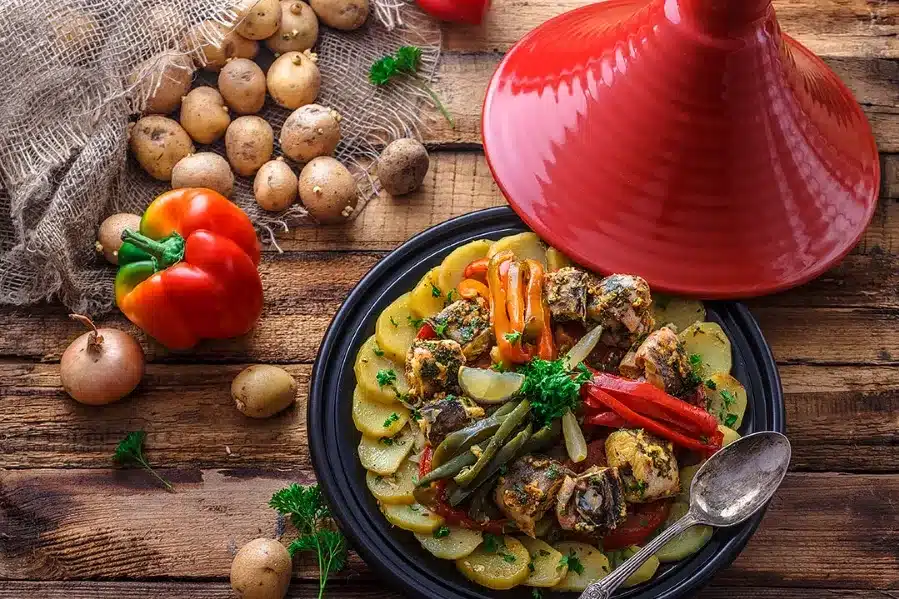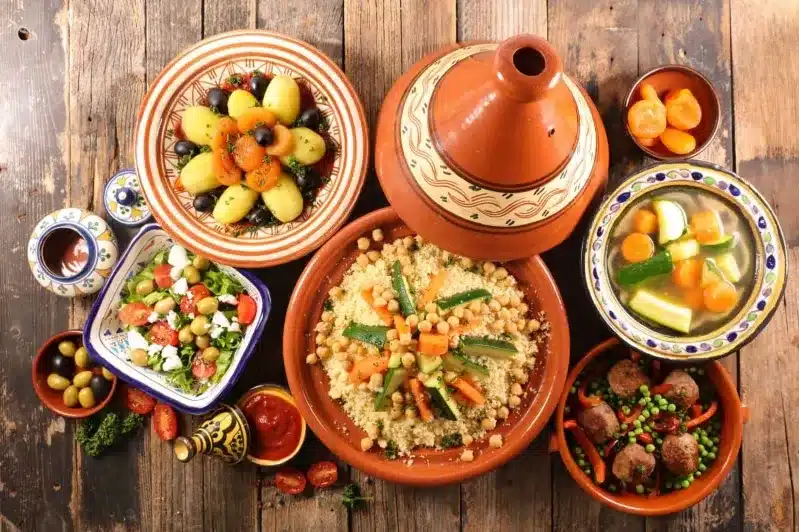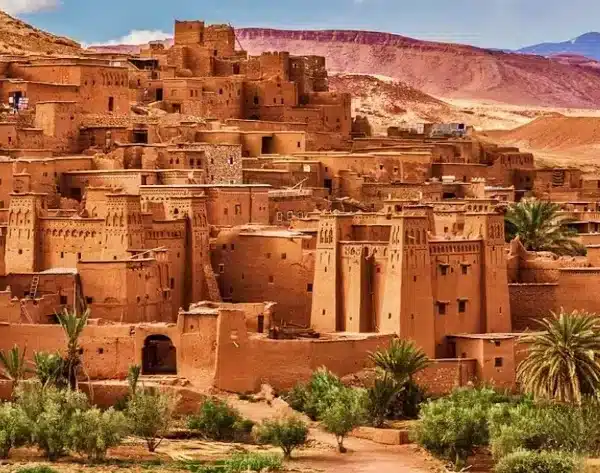
Explore the Best Moroccan Food to Try: Gastronomy Lovers
You are ready to taste the journey of culinary discovery which awaits. Come experience the vibrant food culture and noble practices of Moroccan culinary art. Through its distinctive spices plus natural ingredients Moroccan cuisine presents sensory delights to all visitors who sample it.
Cooked dishes and tea preparations in Moroccan cuisine provide an opportunity to appreciate historic and artistic traditions. This path leads through genuine recipes accompanied by professional chef recommendations which ensures optimal enjoyment during your experience.
The distinguishing feature of this cuisine consists of old world techniques paired with contemporary adaptations. All levels of food enthusiasts can find something to their liking regardless of their experience in the field. This guide will showcase the essential elements and well-known creations that form an unmatchable traditional cooking tradition.
We at Morocco desert tours will lead you to this remarkable gastronomic experience. Our team will discover every aspect and hidden secret of these delightful food creations. Your adventure starts here!
The Cultural Tapestry of Moroccan Cuisine

The culinary tradition uses every dish to present cultural fusion stories. The nation’s historical heritage pervades its cooking customs which produces an exclusive assortment of flavors. The combination of aromatic spices together with fresh elements produces bites which represent centuries of historical evolution.
Discover the magic of this kingdom with our best tours:3 Days Desert Tour from Marrakesh to Merzouga ,4 Days Desert Tour from Marrakech and5 Days from Marrakesh .
A Fusion of Arab, Berber, and Mediterranean Influences

Morocco’s cuisine is a blend of Arab, Berber, and Mediterranean influences. These cultures have shaped the way ingredients are used and combined. For example, olives and tomatoes are staples, adding depth to many dishes. Fresh vegetables also play a key role, making meals both healthy and flavorful.
- Arab traditions introduced spices like cumin and cinnamon.
- Berber techniques focus on slow-cooking methods.
- Mediterranean influence brings olive oil and fresh herbs.
Historical Roots and Modern Twists

Traditional cooking methods of this cuisine developed throughout the historical period of the country. Through time these food traditions transformed themselves while adopting contemporary adaptations. Contemporary chefs work with timeless recipes to develop new dimensions of flavor during their culinary experiments. I believe that all essential components from original recipes maintain their original form even though chefs employ new approaches.
The process of cooking in this cuisine still depends on olives and tomatoes and vegetables for its essential components. The fusion between ancient and modern elements sustains the culinary vibrancy of the cuisine. The historical influence stays visible in all Moroccan dishes regardless of traditional or modern preparation.
Exploring Authentic moroccan food Dishes
A traditional taste discovery leads you to experince food which honors both traditions and culinary delights in every morsel. Traditional moroccan cooking requires dedicated attention to combine traditional spices with fresh components using established techniques. Traditional stews share the menu alongside various light and flavorful choices which meet all dining tastes.
Signature Tagine and Couscous Creations
A tagine functions as one of the essential staples of traditional Moroccan cooking. Through slow cooking the dish reveals a delicious blend of tender meat and vegetables in connection with unique spices. Chicken tagine serves as an exemplary traditional Moroccan dish because it brings together sweet and umami flavors. The traditional tagine dish can be enjoyed in a vegetarian form with chickpeas and other ingredients to create a savory meal.
The staple food couscous functions as a flexible dish suitable next to different protein options. Couscous serves as an appropriate dinner that matches with seafood and vegetables and moderate proteins. The act of making couscous demands skill because inside every grain should be both fluffy and flavorful.
Delicious Meat and Vegetarian Options
Meat lovers will appreciate dishes like lamb tagine or chicken with preserved lemons. These recipes highlight the richness of spices and the tenderness of slow-cooked meat. For seafood enthusiasts, shrimp and fish dishes bring a fresh, coastal twist to the table.
Vegetarian options are equally enticing. Chickpea-based dishes, like harira soup, are packed with flavor and nutrition. These meals showcase the versatility of plant-based ingredients, proving that meatless dishes can be just as satisfying.
- Chicken tagine: A savory blend of spices and tender meat.
- Shrimp couscous: A light, seafood-infused delight.
- Chickpea stew: A hearty vegetarian option rich in flavor.
Each dish reflects generations of culinary expertise, offering a taste of authenticity in every bite. Whether you prefer meat or vegetarian meals, the balance of flavors will leave you craving more.
The Art of Tagine, Couscous, and Stews
These culinary recipes surpass mere recipes through their representation of both patience as well as traditional skills. The tagine cooking process along with the mastery of couscous preparation transform ordinary ingredients into sublime culinary art.
Mastering the Tagine Technique
The tagine represents extraordinary skillful preparation in cooking. A conical lid on the tagine device seals in steam so ingredients cook by steady heat distribution over time. The cooking style with a conical lid enhances multiple tastes so it works well in preparing lamb tagine. Under the cooking process the meat becomes gentle and receives traditional spices like cumin and cinnamon.
A heavy-bottomed pot will serve as a substitute for a tagine if homeowners do not have one. Place vegetables and meat layers in the pan before you start low-heat boiling. The result? The dish produces a thick traditional stew with deep enriching flavors.
Variations of Couscous and Hearty Soups
Couscous is a versatile dish that pairs well with stews and soups. Its light, fluffy texture makes it a perfect base for lamb or vegetable-based meals. Preparing couscous is an art—steam it to ensure each grain is separate and flavorful.
Hearty soups, like harira, are a staple in this cuisine. Made with chickpeas, lentils, and spices, they’re both nourishing and delicious. Serve them with fresh bread to complete the meal.
- Lamb tagine: Slow-cooked with cumin and aromatic spices.
- Chickpea soup: A hearty, vegetarian option packed with flavor.
- Fluffy couscous: The perfect companion to stews and soups.
Bread is an essential part of the dining experience. It’s used to scoop up stews and soups, adding texture and tradition to every bite. Whether you’re enjoying a family meal or experimenting at home, these dishes are sure to impress.
Spices, Herbs, and Ingredients That Define the Flavor
Food from Spain carries its essence from its distinctive combination of powerful spices and crisp ingredients. Multiple elements within Indian cuisine combine harmoniously to develop extravagant foods with robust scents that remain in memory forever. Each ingredient in a spice blend or citrus note contributes significantly to develop the distinct flavor profile of the dish.
Ras el Hanout and Fresh, Local Produce
Ras el hanout is a cornerstone of this culinary tradition. This spice blend, often containing up to 30 ingredients, adds depth and complexity to dishes. It’s a perfect example of how spices elevate flavors, making each bite a sensory experience.
Fresh, local produce is equally important. Ingredients like coriander, lemon, and apricot bring brightness and balance to meals. The tangy zest of lemon or the sweetness of apricot can transform a dish, adding layers of flavor.
- Coriander: Adds a fresh, citrusy note to soups and stews.
- Lemon: Provides a tangy kick, often used in marinades and sauces.
- Apricot: Adds natural sweetness to both savory and sweet dishes.
Fresh juice from local produce is another key ingredient. Whether it’s squeezed lemon juice in a marinade or apricot juice in a glaze, it enhances the natural flavors of the dish. These ingredients, combined with authentic cooking methods, create meals that are both flavorful and memorable.
Sweet Treats, Savory Pastries, and Refreshing Beverages
Experience the combination of sweet and savory delights that characterize this traditional and extensive cuisine. The taste profile features each flavor separately in elegant pastries and invigorating beverages. These creations hold iconic flavors that we need to investigate.
Indulging in Desserts and Pastries
The Morocco desert tour selection and pastry assortment stands as the most exquisite elements in this dining tradition. The harmonious contrast between crispness and richness makes almond-filled pastriesbecome a splendid sweet dessert choice. Honey and nuts together with spices form a divine collection of tastes which characterizes these desserts.
Savory pastries are equally enticing. These snacks consist of filled pastries containing ingredients such as meat, vegetables or cheese and they are readily available on street stands. Pastries offer both a flavorful combination with their delicate crust and delicious fillings which should be tasted by any person who enjoys moroccan food.
The Ritual of Mint Tea and Traditional Drinks
Beyond its drink status mint tea represents a traditional cultural practice in Moroccan society. The beverage traditionally comes with a foamy foam serving as a sign of traditional hospitality. The cocktail of green tea with fresh mint along with sugar makes a delightful beverage that provides both an enjoyably sweet taste and a pleasant aroma.
Traditional beverage offerings play an essential role in Moroccan food culture. Each traditional beverage including spiced coffee and fruit juices enhances the taste experience of Moroccan cuisine. Every meal in morocco Marrakech desert tours features tea as the essential dietary item which unites family and friends.
Street Snacks and Familiar Flavorful Bites
Street snacks offer a taste of everyday life. From grilled meats to spiced nuts, these bites are packed with flavor. They’re perfect for a quick bite while exploring the vibrant streets.
Popular options include fried dough balls and stuffed bread. These snacks showcase the balance of sweetness, spice, and texture that defines this culinary tradition.
- Almond pastries: A sweet treat with a nutty crunch.
- Mint tea: A refreshing drink with a frothy crown.
- Stuffed bread: A savory street snack filled with flavor.
Whether you’re indulging in a dessert or sipping tea, these treats offer a taste of tradition and innovation. They’re a testament to the artistry and creativity of this culinary culture.
Dining Experiences: From Home Cooking to Vibrant Street Food
Eating is a lifelong artistic practice as people enjoy meals in private residences just as they stroll through public areas. Every dining experience provides people with traditional flavors combined with heartfelt moments regardless of whether it occurs at home or in a busy urban area. Multiple unique methods show how food unites human beings.
Authentic Home-Cooked Meals and Family Traditions
The dining culture revolves around the traditional home-prepared meals we all cherish. Families maintaining their heritage by eating traditional family dishes together at the dining space. The culinary selections include fresh salads and accompanying side plates that produce a delightful and nutritious dining experience.
Preserving authenticity occurs through the incorporation of local ingredients when following traditional recipes. Shared cooking efforts connect families as people prepare meals with familiar elements that reinforce traditional customs. The act of dining exists as a broader social practice than consuming food because it serves as a method for people to build connections.
Discovering Street Food Gems and Restaurant Delights
In vibrant cities, street food and restaurants offer a different kind of experience. Street vendors serve up quick, flavorful bites that reflect local flair. From grilled meats to stuffed bread, these snacks are perfect for on-the-go exploration.
Restaurants, on the other hand, blend tradition with innovation. Many dishes are usually served with a modern twist, appealing to both locals and visitors. Whether you’re in a bustling city or a quiet town, the dining scene is always rich with options.
- Home-cooked meals: Preserve family traditions and authenticity.
- Street food: Offers quick, flavorful bites with local flair.
- Restaurants: Combine traditional recipes with modern techniques.
- Salads and sides: Add freshness and balance to every meal.
No matter where you dine, the experience is about more than just the food. It’s a celebration of culture, connection, and creativity. Whether at home or in a city, every meal tells a story.
Conclusion
The moroccan food present visitors with an exciting traditional and creative gastronomic encounter in every eating experience. The year-long evolution of Moroccan cuisine has been formed by key ingredients including pepper and almond. One of the distinctive specialties in Moroccan cuisine features pastilla which blends together sweet and savory tastes.
Perfection in plated cooking requires a harmonious coupling of cooked vegetables with gentle side elements. By using these authentic elements together with modern creative techniques the dishes achieve an authentic yet contemporary character. The outcome has produced a food culture which continues to mesmerize international food enthusiasts around the world.
The exploration of this cuisine remains our ultimate recommendation to readers. People can try Moroccan recipes in their home kitchens or should taste authentic dishes at local eateries to fully explore this cuisine. You should welcome the diverse moroccan food before they make a strong impact on your taste buds.
FAQ
What makes Moroccan cuisine unique?
Moroccan food synthesizes elements from three main traditions which includes Arab, Berber and Mediterranean culinary styles. Tagine and couscous represent Moroccan cooking by showing how fresh ingredients and spices and herbs come together.
What dishes in Morocco should no visitor miss?
Customers should experience tagine along with couscous and pastilla and harira soup. The typical Moroccan dishes represent our cultural eating habits while chicken, lamb and vegetables are regular ingredients.
What are the steps for preparing Moroccan mint tea?
Preparation of mint tea includes steeping green tea leaves and fresh mint leaves along with sugar. Hospitality guests receive this delightful drink as they enjoy its refreshing quality.
The traditional spices used in Moroccan cuisine consist of which ingredients?
The cuisine of Moroccan cooking includes numerous spices which include cumin and coriander and ras el hanout. Spice blends from Morocco bestow layers and heightened complexity to traditional dishes of stew and grilled meats.
Are vegetarian dishes available within the food selection of Moroccan cuisine?
We have various vegetarian menu options which include vegetable tagine together with chickpea stew as well as salads. The food eaters in Morocco relish because its assortment of flavors uses assorted spices and herbs and fresh vegetables.
Tagine holds what special position does it occupy in traditional Morocco cooking methods?
The ceramic oven known as tagine serves both as an earthen vessel and as one of its distinctive prepared dishes. Tagine serves as an appliance to cook meats as well as vegetables and spices at low heat for tender aromatics outcomes.
Are there traditional Moroccan desserts?
The traditional Moroccan cuisine includes almond pastries alongside apricot-filled treats and sweets that receive honey drenching. The Moroccan dessert selection can be paired with mint tea as well as special celebratory occasions.
Does Moroccan cuisine exist only in restaurants in Morocco?
The traditional Moroccan dining experience can be found through home-based meals and both casual restaurants and street stalls. The cuisine presents distinct ways for consumers to experience our conventional moroccan food tastes.
See more
Last Minute Deals
- Quality4
- Location4
- Amenities4
- Services2
- Price5
4 Days from Marrakesh-Skoura Palm Oasis-Merzouga and Erg Chebbi dunes back to Marrakesh
- Quality5
- Location5
- Amenities5
- Services5
- Price4
Agafay Desert Trip Quad Bike /camel Ride /tea Break /dinner & Transport
- Quality4
- Location4
- Amenities4
- Services2
- Price5










